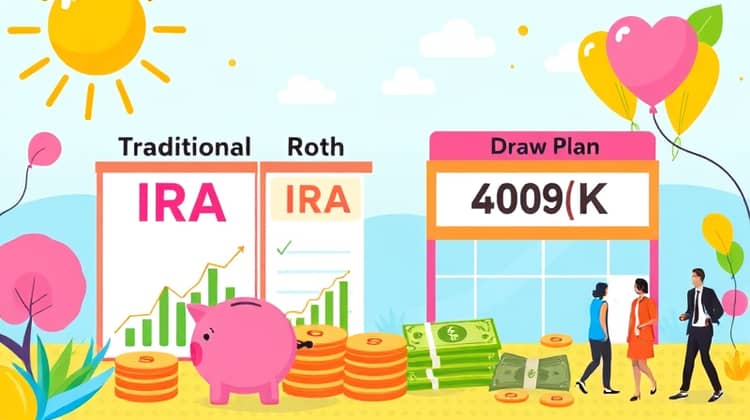Understanding retirement accounts is crucial for anyone planning for their financial future. Retirement accounts not only provide a means to save money for the future but also offer significant tax benefits that can enhance your overall savings. In this article, we'll explore the various types of retirement accounts, their associated tax benefits, how to contribute to them, and important considerations around contribution limits and deadlines.
By utilizing retirement accounts effectively, individuals can navigate the complexities of saving for retirement while minimizing their tax liabilities. Knowing how to leverage these accounts can significantly impact how much money is available for you during retirement. Let's dive into the intricacies of retirement accounts and discover the best strategies for maximizing your contributions and benefits.
1. Understanding Retirement Accounts

Retirement accounts are specialized financial accounts designed to help individuals save for retirement while reaping tax advantages. They allow you to set aside funds over many years, which can then grow tax-deferred (or tax-free, in some cases) until withdrawal during retirement. Understanding how these accounts work is essential for anyone looking to secure their financial future.
One primary reason these accounts exist is to encourage individuals to take an active role in their retirement planning. With the decline of traditional pension plans, people are increasingly responsible for their financial security in retirement. Retirement accounts serve as an attractive solution for building a nest egg while providing additional tax benefits.
There are various types of retirement accounts available, each with distinct features, benefits, and rules regarding contributions and withdrawals. Familiarizing oneself with these options is critical to making informed decisions that align with one's financial goals.
2. Types of Retirement Accounts

In order to make the most of your savings, it’s important to choose the right type of retirement account that fits your financial situation and goals. Here are some of the most popular options available for retirement savings:
- Traditional IRA
- Roth IRA
- 401(k) Plans
Each of these accounts comes with specific rules and benefits, particularly regarding taxation and withdrawals. Depending on your employment status, income level, and long-term financial plans, one option may be more advantageous than the others.
a. Traditional IRAs
Traditional IRAs, or Individual Retirement Accounts, are designed to provide tax-deferred savings. Contributions to a Traditional IRA may be deductible on your tax return, effectively reducing your taxable income for the year. This means you can potentially lower your tax bill while saving for retirement—a win-win situation.
The funds within a Traditional IRA grow tax-deferred until you reach age 59½. At this point, you can begin withdrawing funds without incurring penalties, although these withdrawals will typically be subject to income tax based on your current tax bracket. This mechanism allows your investments to grow over time without immediate tax implications.
It’s also worth noting that Traditional IRAs have specific contribution limits and may have income thresholds that determine the deductibility of contributions. Understanding these limitations is crucial for maximizing the benefits of your retirement savings.
b. Roth IRAs
Roth IRAs are another popular retirement savings vehicle that allows for tax-free growth and tax-free withdrawals in retirement. Unlike Traditional IRAs, contributions to a Roth IRA are made with after-tax dollars, which means you have already paid taxes on the money before contributing to the account.
The key benefit of a Roth IRA lies in its withdrawal rules. Since your contributions were taxed already, you can withdraw those contributions at any time without penalty. Additionally, qualified withdrawals of earnings are also tax-free after age 59½, provided the account has been open for at least five years. This feature makes Roth IRAs especially attractive for young investors who expect to be in a higher tax bracket in the future.
c. 401(k) Plans
401(k) Plans are employer-sponsored retirement savings plans that allow employees to save for retirement directly from their paychecks. This type of account has gained popularity because many employers offer matching contributions, which can significantly boost your retirement savings.
Contributions to a 401(k) are made using pre-tax dollars similar to Traditional IRAs, thus lowering your taxable income in the year of contribution. This deferred taxation allows your investments to grow without being taxed until you withdraw them. However, employees should be mindful of the contribution limits and potential fees associated with their specific 401(k) plans.
3. Tax Benefits of Retirement Accounts

The tax advantages provided by retirement accounts are pivotal in shaping the investment strategies for individuals planning for retirement. Each account type offers unique benefits that can lead to substantial savings on taxes over the long term. Understanding these advantages can help you optimize your retirement planning efforts.
For instance, contributions to Traditional IRAs and 401(k) accounts can reduce your taxable income in the present, allowing you to invest that lump sum for growth. Meanwhile, Roth IRAs allow for tax-free withdrawals in retirement, providing financial flexibility when you may need it most.
These benefits highlight the importance of contributing to retirement accounts consistently throughout your working years, ensuring that you take full advantage of the tax-sheltered growth opportunities they present.
a. Traditional IRA and 401(k) Tax Benefits
Traditional IRAs and 401(k) plans both offer upfront tax deductions on contributions, which can be particularly beneficial during your peak earning years. By lowering your taxable income, you may fall into a lower tax bracket, potentially saving hundreds or thousands in taxes annually.
Moreover, the investment growth within these accounts is tax-deferred, meaning you won't owe taxes on dividends, interest, or capital gains until you withdraw the funds in retirement. This allows you to reinvest more of your money and take advantage of compound growth over time.
b. Roth IRA Tax Benefits
With a Roth IRA, the tax benefits are primarily realized at the point of withdrawal rather than at the time of contribution. Since contributions are made with after-tax dollars, you do not receive an immediate tax break. However, the long-term benefits are substantial: qualified withdrawals are completely tax-free in retirement, making it an attractive option for many.
Additionally, Roth IRAs do not impose required minimum distributions (RMDs) during the account holder's lifetime, offering greater flexibility in retirement planning. This means you can potentially leave your investments untouched for a longer period, allowing them to grow even more before you decide to withdraw.
4. How to Contribute

Contributing to a retirement account can seem daunting, but the process is relatively straightforward. Your first step is to determine which type of retirement account fits your financial situation and goals the best. Once you've made that decision, you can set up your account through a financial institution or employer.
Most employers with 401(k) plans will automatically deduct contributions from your paycheck, making it a seamless way to save. For Traditional and Roth IRAs, you can initiate contributions through an individual financial institution, either in a lump sum or through regular contributions throughout the year.
It's important to remember to regularly review your contributions and adjust them as necessary, especially if you receive salary increases or changes in your financial situation.
- Set up automatic contributions from your paycheck if available.
- Consider starting with a percentage of your income as a contribution amount.
- Regularly review your financial situation and increase contributions when feasible.
By actively contributing to your retirement accounts, you are taking tangible steps toward securing your financial future and maximizing your potential for long-term growth.
5. Contribution Limits and Deadlines

Each retirement account type comes with its own set of contribution limits that can affect how much you save each year. For instance, as of 2023, the contribution limit for a 401(k) plan is significantly higher than that of an IRA, allowing for more aggressive saving strategies in employer-sponsored accounts.
It's also crucial to be mindful of deadlines for contributions, especially when considering tax deductions. Traditional and Roth IRAs allow contributions until the tax filing deadline of the following year, while 401(k) contributions often need to be made throughout the calendar year.
Failing to adhere to these limits and deadlines could mean missing out on potential tax savings and growth opportunities for your retirement fund, so it's essential to stay informed and proactive in managing your accounts.
6. Tips for Maximizing Tax Benefits

Maximizing tax benefits from retirement accounts requires strategic planning and disciplined saving habits. One effective strategy is to start contributing as early as possible to take advantage of compound growth, which can significantly increase your funds over time. The earlier you start, the more time your money has to grow.
Contributing at least enough to receive any employer match is essential if you have a 401(k). This is essentially ‘free money’ that adds to your retirement savings. Allocating your investments wisely according to your risk tolerance and retirement timeline is also vital for long-term success.
Furthermore, keep track of any tax changes, contribution limits, and investment environments to ensure your strategy remains effective.
- Start contributing early to maximize compound interest.
- Ensure you contribute enough to receive employer matches in your 401(k).
- Review and adjust your contributions as needed based on financial changes.
By implementing these strategies, you can significantly enhance your retirement savings while also enjoying the various tax advantages that these accounts offer.
7. Conclusion

Understanding the intricacies of retirement accounts, their types, and associated tax benefits is essential for anyone looking to secure their financial future. As the landscape of retirement planning evolves, being proactive about contributions and investment strategies will prove beneficial in the long run.
The importance of consistently contributing to retirement accounts cannot be overstated. It's the key to building substantial savings and either reducing your taxable income today or providing tax-free income in the future.
By taking full advantage of the available retirement accounts and their unique benefits, individuals can ensure a comfortable and financially stable retirement.














